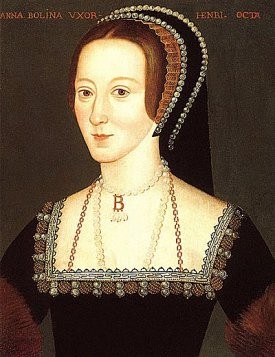Anne Boleyn

Anne Boleyn, Henry VIII's ill-fated second wife, was educated in France and returned to England as a by all accounts sparkling young woman. The lore that Anne Boleyn was the sole or at least main reason for the triumph of the French Hood over the apparently old-fashioned Gable Hood in her time is, however, doubtful.
Anne Boleyn was born between 1501 and 1507. Yet 1499 and 1512 have also been mentioned as possible years of birth. Anne's father was a diplomat at Henry's court. She was sent abroad for her education: first to the Burgundian Netherlands (now Belgium) and later to France. In Belgium she served the Archduchess Margaret who was very much impressed with the girl's cleverness and good manners. After about a year Anne was sent to France to be a maid of honour to Queen Mary and later to her stepdaughter Queen Claude. With Claude she stayed nearly seven years. There, she had the opportunity to learn French perfectly, to acquire knowledge on etiquette, to study music, art, fashion and religious literature and poetry. As a courtier, she naturally learned about court culture and all the intrigues and politics that come with Renaissance-era seats of power. Anne was very clever and a dedicated scholar and reader, especially on the topic of religious reform.
Anne Boleyn made her first appearance at the English court at the Chateau Vert (French: "Green Castle"), a pageant on 4 March 1522. She played the part of "Perseverance". The habits and distinctly French style Anne brought with her were exciting to the English court and helped to make her a centre of attention. On 1 June 1533 Anne Boleyn was crowned Queen of England. She had already been the wife of King Henry VIII since January and the object of his admiration for more than seven years. Despite all her fashionable upbringing Anne did not introduce the French Hood and banish the aged Gable Hood alongside Queen Catherine, as legend has it. The only surviving certain likeness produced during her lifetime is a medal of Anne with her "moost happi" device in which she wears the traditional gable hood. There is, however, the story that Jane Seymour deliberately wore the Gable Hood to seem more traditionally English and style herself as a modest, obedient wife to Henry. It has to be remembered that headwear was, like all dress styles, fluid and complex. The French versus Gable Hood matter as it appears today was to Anne's contemporaries probably not nearly as much a 'versus' but rather a cohabitation of different styles where upper class women could choose according to preference, budget, occasion and rank.
© Epochs of Fashion
